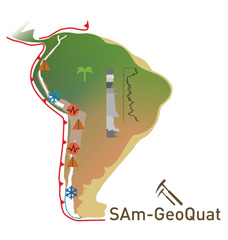

(i) To link the scientific geologic communities from SA and dedicated to the research of the Quaternary that do not usually work together.
(ii) To bring field active specialists together (mainly DCRs) and interested in the Quaternary period, with study areas in the continent and to allow researchers with different backgrounds to meet (especially in the field), to interact and exchange data and interpretations and also discuss common approaches for studying geological processes along a variety of tectonic settings, with the aim of achieving integrated results.
(iii) To obtain cross-disciplinary and cross-regional correlation of geological records in different settings of SA with the aim of seeking international forums to discuss results and to review the advances on the studies that link research on Quaternary continental environments and tectonics. The results will contribute with information useful to programs of mitigation of societal impacts from natural hazards in SA (extreme climatic events, earthquakes, volcanic eruptions).
(iv) To organize workshops and field meetings to discuss innovative approaches aiming to enhance our understanding of the interplay between tectonic and climatically controlled processes that have created landforms and sedimentary sequences of representative regions of SA and spanning the last interglacial-glacial cycle. The aim is to promote innovative contributions on the application of new and established methodological approaches to advance on the stratigraphical (sequence stratigraphy and event stratigraphy), geomorphological, sedimentological, geochronological and paleoenvironmental assessment
(v) To compile and interlink fluvial, glacial, lacustrine, colluvial and coastal records, because of their widespread distribution on the continent, and their value in registering comparatively rapid response to tectonic and climate influences. We specially target paleaoenvironmental records retrieved from selected geological settings and covering the last interglacial-glacial cycle in order to analyse the correlation between them.
(vi) To advance on the palaeoenvironmental assessment of aeolian-paleosols sequences (loess-dunes) and pyroclastic and volcaniclastic sequences of key selected regions of SA during the last interglacial-glacial cycle.
(vii) To establish initiatives for a close interaction between the different sub-groups using up-to-date and new technologies to better resolve standing issues dealing with the chronology of well-identified environmental changes (luminescence, accelerator 14C, U series, AAR, geochemical mass spectrometry, geophysics). It can provide more inter-regional and continental chronologies of representative sequences in relation with environmental changes during the last interglacial-glacial period in the continent.
(viii) To begin with the compilation of geological data with the mid- to long-term objectives of creating a public-access database of Quaternary records of SA, including a list of Doctoral Thesis and relevant papers published in local geological journals that are difficult to access for non-local researchers
(ix) To produce, as a collective of authors, a series of research results and papers that exceeds the capacity of us as individuals. The results will be focused on the influence of volcanism, tectonics, and climatic forcing on the landscape evolution and on the sedimentary records of representative regions of the continent during the Late Quaternary. It will constitute a synthesis of existing results in order to establish a present state of knowledge.
(x) To organize international field trips and field courses in Argentina and Brazil in the year 2013 and extended to other SA countries in 2014 (Venezuela confirmed) and 2015. The trips will constitute long transects that allow visit and discuss in situ representative outcropping sequences and landforms.
(xi) To seek and propose common sessions in forthcoming international conferences about the thematic areas involved and to propose and arrange publication of papers, mainly in a special volume of Quaternary International at the end of the initiative. It will include the rescue of existing unpublished datasets.
xii) To recognize specific areas for field discussions, where the Quaternary record requires different analysis perspectives and interaction that brings together colleagues with diverse backgrounds (i.e. understanding problems in areas with Quaternary volcanism, tectonism and related stratigraphic, geomorphic processes). It means bridging the gap between interpretations of similar features in the Quaternary resulting from way different processes (e. g. liquefaction vs sin-sedimentary structures, etc)








